EVOH masterbatch is a granular material made from ethylene vinyl alcohol copolymer (EVOH) as the substrate, with various functional additives added. EVOH is a polymer material with excellent performance. Ethylene and vinyl alcohol are usually polymerized to form EVOH resin, which is then mixed and granulated with various additives (such as antibacterial agents, antioxidants, lubricants, etc.) in specific equipment to produce EVOH masterbatch.
Types and Applications
EVOH masterbatch can be divided into the following common types based on their functions and applications:
Barrier type EVOH masterbatch
Features: It has outstanding gas barrier performance, which can effectively block the penetration of gases such as oxygen and carbon dioxide, and also has good barrier effect on water vapor. This is the most common type of EVOH masterbatch, mainly designed and produced based on the high barrier properties of EVOH itself.
Application: Widely used in industries such as food, medicine, cosmetics, etc. that require high packaging barrier performance. In food packaging, it can be used to package food that is prone to oxidation and spoilage, such as potato chips, nuts, etc., to prevent oxygen from entering and causing food spoilage; In pharmaceutical packaging, it can protect drugs from the influence of oxygen and water vapor in the air, ensuring the stability and effectiveness of drugs.
Antibacterial EVOH masterbatch
Features: Antibacterial agents have been added to EVOH masterbatch, giving it the ability to inhibit or kill microorganisms such as bacteria and mold. Antibacterial agents usually have long-lasting and broad-spectrum properties, and can continue to exert antibacterial effects for a certain period of time.
Application: Suitable for fields with high hygiene requirements, such as food packaging, medical product packaging, etc. In food packaging, it can reduce the growth of microorganisms on the surface of food and extend the shelf life of food; In the packaging of medical supplies, it can effectively prevent bacterial contamination and ensure the safety of medical supplies.
Weather resistant EVOH masterbatch
Features: Added anti UV agents, antioxidants and other additives to improve the weather resistance and stability of EVOH masterbatch in outdoor environments. It can resist the influence of environmental factors such as ultraviolet radiation, temperature changes, and humidity, and is not prone to aging, discoloration, brittleness, and other phenomena.
Application: Commonly used in outdoor packaging materials, agricultural films, and other fields. For example, using weather resistant EVOH masterbatch in agricultural films can maintain good performance during long-term outdoor use, extend the service life of the film, and provide a stable growth environment for crops.
Processing modified EVOH masterbatch
Features: By adding various processing aids such as lubricants, dispersants, plasticizers, etc., the processing performance of EVOH is improved. Reduce its melt viscosity, improve fluidity, make EVOH easier to form in extrusion, blow molding, injection molding and other processing processes, reduce processing defects, and improve production efficiency and product quality.
Application: It is used in the production of various EVOH products, especially in fields that require high processing accuracy and efficiency, such as high-end packaging products, electronic component packaging, etc. EVOH can better adapt to different processing techniques and equipment, meeting diverse production needs.
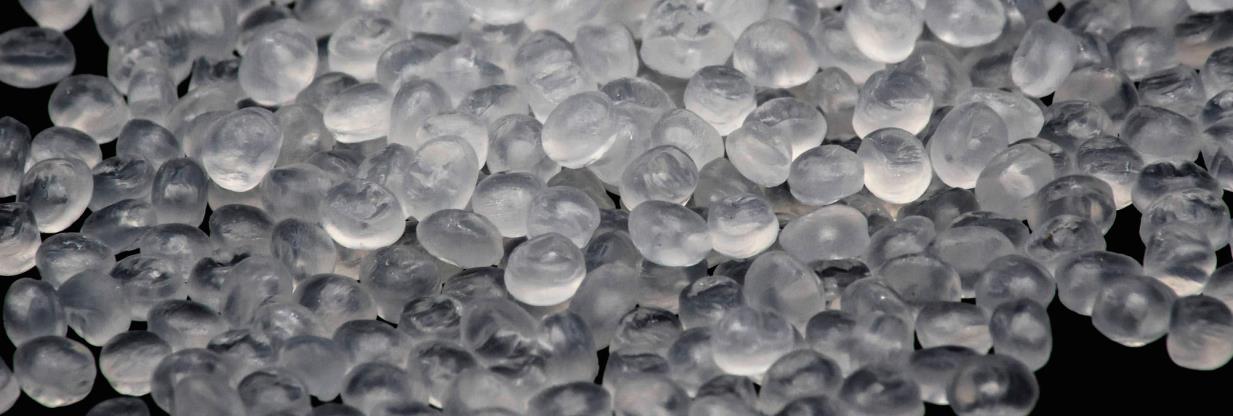
Formula ratio
The formula ratio of EVOH masterbatch may vary depending on specific applications and performance requirements. Here are some common formula ratio examples:
EVOH masterbatch formula for barrier layer: When producing high permeability automotive fuel tanks, one barrier masterbatch formula is HDPE (70%), EVOH (20%), HDPE grafted maleic anhydride (9%), antioxidant 1010 (0.8%), and antioxidant DSTP (0.2%). By blending these components and adding them to an extruder for granulation, EVOH masterbatch for barrier layers can be obtained.
EVOH masterbatch formula for two-layer structure alloy oxygen barrier PERT tube: First, place EVOH in a 110 ℃ blast drying oven for 4 hours, and then weigh EVOH according to the proportion PERT、 Mix compatibilizers (such as va1202, nf468) in a high-speed mixer for 10 minutes. Among them, the ratio of EVOH to PERT ranges from 6:4 to 1.5:8.5, and the amount of compatibilizer added is 5-16phr.
A formula for preparing graphene microsheet barrier masterbatch: One formula is HDPE (85%), graphene microsheets (8%), HDPE grafted with maleic anhydride (6%), antioxidant 1010 (0.8%), and antioxidant DSTP (0.2%). After blending, it is added to the extruder for granulation to produce graphene micro sheet barrier masterbatch. However, EVOH is not the main component here, but only one of the optional barrier materials.
In addition, when preparing antibacterial EVOH masterbatch, EVOH is usually used as the substrate and a certain proportion of antibacterial agent is added. The amount of antibacterial agent added may be around 1% -5%, and the specific proportion needs to be determined according to the antibacterial effect requirements and the activity of the antibacterial agent. When preparing weather resistant EVOH masterbatch, additives such as anti UV agents and antioxidants are added. Generally, the amount of anti UV agents added is around 0.5% -2%, and the amount of antioxidants added is around 0.1% -1%.
Production process
The production process of EVOH masterbatch usually includes steps such as raw material preparation, mixing, extrusion, granulation, etc., as follows:
1. Raw material preparation
Choosing the appropriate type of EVOH resin may require the preparation of various additives such as antibacterial agents, UV resistant agents, antioxidants, lubricants, plasticizers, etc. based on product performance requirements. Ensure that the quality and purity of raw materials meet production requirements, dry the raw materials to remove moisture, and prevent the formation of bubbles or affecting product performance during processing. For example, dry EVOH resin in a blast drying oven at 110 ℃ for 4 hours.
2. Mixing
According to the designed formula ratio, accurately weigh EVOH resin and various additives, and add them to a high-speed mixer for thorough mixing. By high-speed stirring, the additive is uniformly dispersed in EVOH resin to form a premix. The mixing time is generally 10-15 minutes to ensure uniform mixing of the materials.
3. Extrusion
Add the premix into the twin-screw extruder. Twin screw extruders have good mixing and conveying capabilities, which can fully melt and mix materials at high temperatures and pressures. During the extrusion process, it is necessary to control the temperature, speed, and pressure parameters of the extruder. Generally speaking, the temperature of the extruder is set between 180-240 ℃ and adjusted according to different EVOH models and additive characteristics. The speed is usually between 100-300 revolutions per minute to ensure uniform extrusion of the material and good plasticizing effect.
4. Granulation
The molten material extruded from the extruder is formed into continuous strips or filaments through the die head, and then enters the granulation equipment. Common granulation methods include air-cooled granulation, water-cooled granulation, and underwater granulation. Air cooled pellet cutting is the process of cooling extruded strips through an air cooling device and then cutting them into pellets using a pellet cutter; Water cooled pellet cutting is the process of cooling the strip material through a water tank before cutting it into pellets; Underwater granulation is the process of directly cutting molten material into particles underwater. This method produces particles with regular shapes, smooth surfaces, and high quality, but the equipment cost is also relatively high.
5. Screening and packaging
The EVOH masterbatch after granulation is screened by vibrating screens and other equipment to remove particles that are too large or too small, ensuring uniform particle size of the product. The qualified masterbatch after screening is packaged, usually in sealed packaging, to prevent the masterbatch from being affected by moisture, oxidation, or other contamination that may affect product performance.
In the production process, in order to ensure the stability and consistency of product quality, it is necessary to strictly control the quality of each link in the production process, including quality testing of raw materials, performance testing of intermediate products, and comprehensive inspection of the final product.
Production equipment
The EVOH masterbatch production equipment mainly includes raw material processing equipment, mixing equipment, extrusion granulation equipment, auxiliary equipment, etc. The following is a specific introduction:
1. Raw material processing equipment
Drying machine: used for drying EVOH resin and other raw materials to remove moisture. Common ones include blast drying oven, vacuum dryer, etc. The blast drying oven has a simple structure and low cost, suitable for general drying requirements; A vacuum dryer can quickly dry raw materials at lower temperatures, avoiding deterioration at high temperatures, and is suitable for situations where high drying conditions are required.
2. Hybrid equipment
High speed mixer: It is a key equipment for mixing EVOH resin with additives. It achieves uniform mixing of materials in a short period of time through high-speed rotating stirring blades. It has the advantages of high mixing efficiency and good mixing uniformity, and can meet the mixing needs of different formulas.
3. Extrusion granulation equipment
Twin screw extruder: It is one of the core equipment for EVOH masterbatch production. It has good material conveying, mixing, and plasticizing capabilities, which can fully melt and uniformly mix EVOH resin and additives under high temperature and high pressure. The screw structure and aspect ratio of twin-screw extruders can be selected and adjusted according to different production processes and product requirements to achieve the best extrusion effect.
Granulator: Used in conjunction with a twin-screw extruder, it cuts extruded strip or filamentous materials into granules. According to the different cutting methods, it can be divided into air-cooled pelletizers, water-cooled pelletizers, and underwater pelletizers. The air-cooled granulator is suitable for occasions where the appearance requirements for particles are not high; The surface of the particles produced by the water-cooled granulator is relatively smooth; The underwater granulator has high production efficiency, regular particle shape, and good quality, and is commonly used in the production of high-end products.
4. Auxiliary equipment
Feeding machine: used to automatically transport raw materials to mixers or extruders, achieving automation of raw material transportation, improving production efficiency, and reducing manual labor intensity. Common ones include screw feeders, vacuum feeders, etc.
Cooling equipment: During the extrusion granulation process, the material is cooled to quickly solidify and form. For air-cooled pellet cutting, an air-cooled system is usually equipped, including fans and cooling pipes, etc; For water-cooled granulation and underwater granulation, a circulating water cooling system is required, including a cooling water tank, water pump, and cooling pipeline, to ensure the cooling effect and stable water temperature.
Screening equipment: Screen the EVOH masterbatch after granulation to remove particles that do not meet the particle size requirements. The commonly used screening equipment includes vibrating screens, which classify and screen particles through different mesh sizes to ensure the uniformity of product particle size.
Packaging equipment: used for packaging qualified EVOH masterbatch after screening. Common packaging equipment includes automatic packaging machines, which can automate packaging processes such as measurement, filling, and sealing, improve packaging efficiency and quality, and ensure that products are not affected by moisture or pollution during storage and transportation.
EVOH masterbatch extruder
Kerke’s masterbatch extruder can be used to produce EVOH masterbatch. Our EVOH masterbatch extruder has multiple models to choose from, which can meet different production requirements.
-

Laboratory Twin Screw Extruder
When will you need a lab twin screw extruder? If you want to make trials and tests of…
-
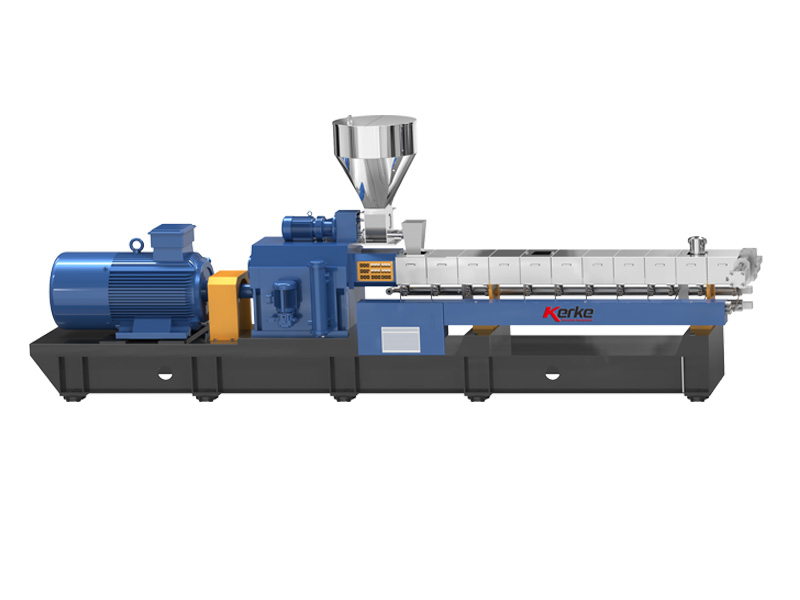
Parallel Twin Screw Extruder
Our Parallel Co-rotating twin screw extruder is designed for compounding and masterbatch making with an output capacity from…
-
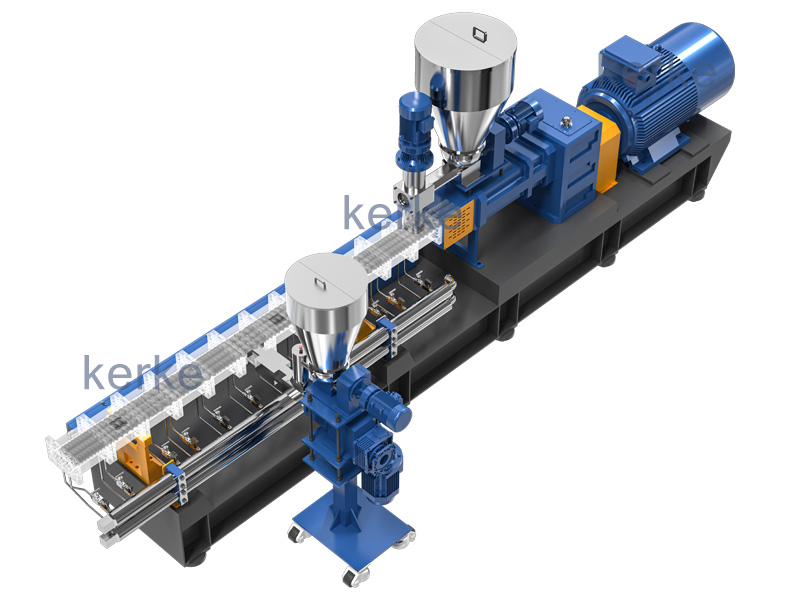
Triple (3 screws) Extruder
3 Screws extruder is a new technology that has many advantages. The triple screw extruder is mainly used…
-
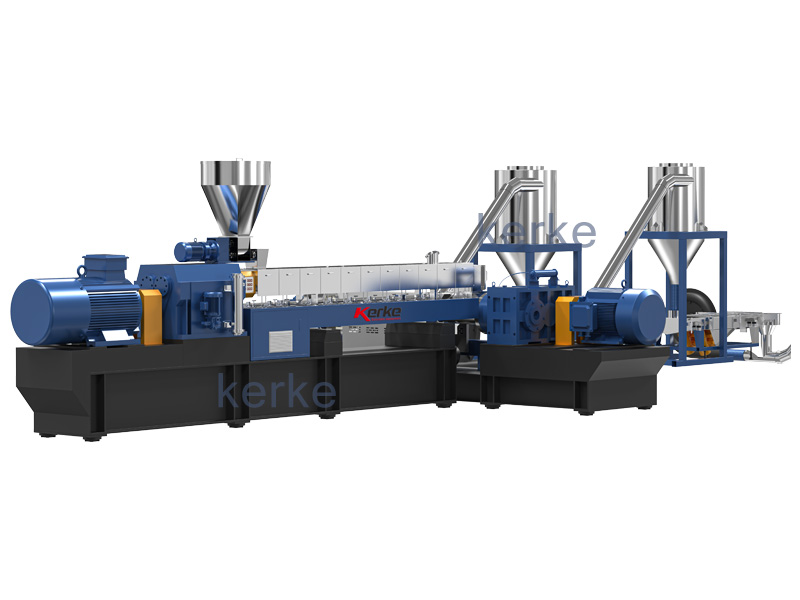
Double-Stage Extrusion System
Mother-baby extrusion system is designed for special materials which can not process on one stage extruder, the first…
-
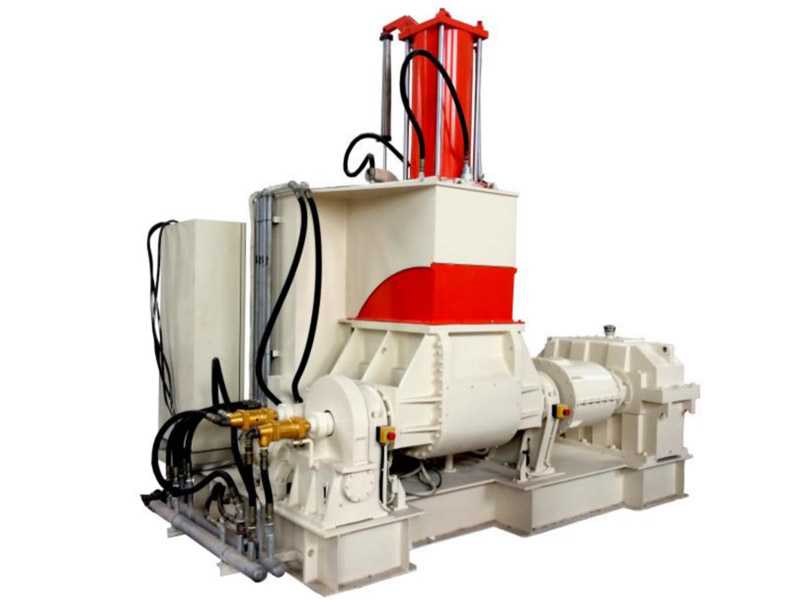
Banbury Kneader Compounding Line
Our kneader + extruder is designed for making special applications with an output capacity from 30kg/h to 1000kg/h.…
-
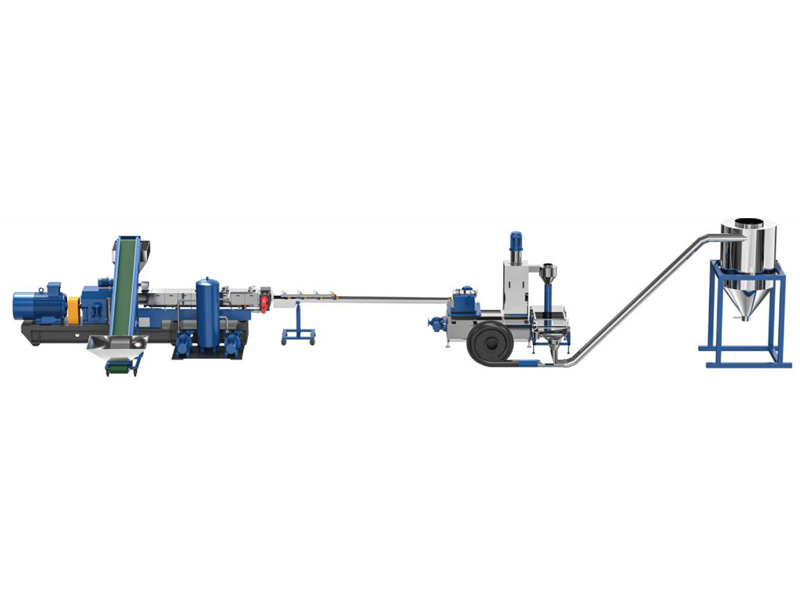
Cutting System / Pelletizing System
Different material needs different cutting system, Kerke provides all kinds of cutting system, here is the explanation of…
Related requirements
The extruder plays a key role in the production of EVOH masterbatch, and the following are some requirements for the extruder:
Screw design
High mixing capacity: In the production of EVOH masterbatch, it is necessary to thoroughly mix EVOH resin with various additives. The screw should have special mixing elements, such as kneading blocks, toothed discs, etc., which can generate strong shear and stretching effects, ensuring that the material is thoroughly mixed during extrusion and ensuring that the additives are evenly dispersed in the EVOH matrix.
Appropriate aspect ratio: A screw with a larger aspect ratio is beneficial for the full plasticization and mixing of materials. For the production of EVOH masterbatch, a length to diameter ratio between 25-40 is generally suitable. Longer screws can provide sufficient residence time for materials to fully melt at high temperatures and pressures, while also helping to improve extrusion stability and product quality consistency.
Gradient screw: Due to the melting characteristics of EVOH resin, gradient screws are usually used. The groove depth of this screw gradually becomes shallower from the feeding section to the homogenization section, which can gradually compress and shear the material during the extrusion process, achieve smooth melting and plasticization, and reduce material fluctuations during the extrusion process.
Temperature control
Accurate temperature control system: EVOH masterbatch production has strict temperature requirements. The extruder should be equipped with a high-precision temperature control system, which can accurately control the temperature of each heating section. The temperature control accuracy is usually required to be within ± 1 ℃. This helps ensure that EVOH resin melts at the appropriate temperature, avoiding degradation of EVOH due to high temperatures or poor plasticization due to low temperatures.
Multi stage temperature control: In order to meet the heating and cooling needs of materials at different stages, extruders usually need to have multi-stage temperature control functions. It is generally divided into multiple areas such as feeding section, compression section, homogenization section, etc. Each area can be independently temperature adjusted to adapt to the physical changes and chemical reactions of the material during the extrusion process.
Pressure control
Stable extrusion pressure: In EVOH masterbatch production, stable extrusion pressure is crucial for ensuring product quality. The extruder should be able to provide stable pressure to evenly pass the material through the die during the extrusion process, avoiding problems such as uneven particle size and poor surface quality caused by pressure fluctuations.
Pressure regulating device: The extruder needs to be equipped with a pressure regulating device, such as a back pressure valve, in order to flexibly adjust the extrusion pressure according to different material characteristics and production process requirements. By adjusting the back pressure, the residence time and shear degree of the material in the screw can be controlled, thereby optimizing the performance and quality of the product.
Driving system
High torque drive: Due to the high viscosity of EVOH resin in the molten state, the drive system of the extruder needs to provide sufficient torque to push the material forward. Therefore, extruders typically use a combination of high-power motors and gearboxes to ensure stable power output at different production speeds and material viscosities.
Good speed regulation performance: The drive system should have good speed regulation performance and be able to achieve stepless speed regulation over a wide range. This allows operators to flexibly adjust the speed of the extruder according to the requirements of the production process, in order to adapt to different material formulations, production volumes, and product quality requirements.
Material and Corrosion Resistance
Corrosion resistant materials: Considering that some additives may be corrosive, the screw, barrel, and other components of the extruder that come into contact with the material should be made of corrosion-resistant materials such as stainless steel, alloy steel, etc., and surface treated with chrome plating, nitriding, etc. to improve the corrosion resistance and wear resistance of the components and extend the service life of the equipment.
Cleanliness: In order to avoid cross contamination between different batches of materials, the internal structure of the extruder should be easy to clean. The screw and barrel should be easy to disassemble and assemble, so that residual materials inside can be thoroughly cleaned when changing product formulas or performing equipment maintenance.






